It looks like you're using an Ad Blocker.
Please white-list or disable AboveTopSecret.com in your ad-blocking tool.
Thank you.
Some features of ATS will be disabled while you continue to use an ad-blocker.
share:
In a few threads recently the topic of ancient art, and when Humans made certain representational breakthroughs has been discussed. It's a
fascinating subject and feeds in very closely to the differing perceptions that many of us have regarding human development and how culturally
advanced our ancestors were. I'm hoping that some of the items i'm posting here will be new to some readers and provoke interesting discussion. The
process that lead me to make this thread was in response to a discussion with another poster here at ATS and while composing my reply i came across
the two very ancient (possible) artistic artefacts in this thread, and having learned something myself in this process i decided it was worthy of a
slightly different tack and therefore the creation of a new thread.
I'm no expert on the History of Art - it is a particularly massive subject and for many people a life's work, but i am fascinated by it and have read pretty widely on particularly Stone-Age to Bronze-Age art and how it relates to psychology and mythology. I see it as one of the corner stones to developing an understanding of our past and believe that placing Art works in context and seeing their progression encourages accuracy in interpretation, promoting productive discussion, speculation and so forth - when discussing myth, story and scripture as well as other aspects of culture, cognitive development, technology. This is a selection, and by no means a definitive list and i welcome contributions, additions, corrections and so forth - i've learned new things while gathering info for this thread and i'm keen to learn more from reader's contributions, so have at it!
This Site proved me with a useful template/reminders and was worth a mention/credit information, pictures and so forth have been taken from a variety of sources which i will link as i go...
The World's Oldest Artworks
The Daraki Chattann Cave Petroglyphs and Paintings
A cave in India (and World Heritage site) that was possibly first inhabited seven hundred thousand years ago. This contains over 500 carved/pecked cup markings in the cave walls that date to about 250,000 years ago, and the hammer-stones that are thought to have been used to make these have also been unearthed.

Some are interpreted as representing Elephants, though this is the best pic that i could find and it's abstract to say the least:

nearby rocks have been seen by some as other Elephant carvings, though i've seen more likely ones in Mars rocks threads and i don't believe that pictures of them are worthy of inclusion.
There are also many incredible, much later cave paintings
Bhimbetka Rock Carvings
Another site in India (also known as Auditorium Cave) that contains cup marks and engraved lines like Daraki Chattann.

The main reason i include this site are for the amazing stones that have been hammered away at to conclusively resemble Elephants, and are at least 200,000 years old, maybe even more than 500,000:
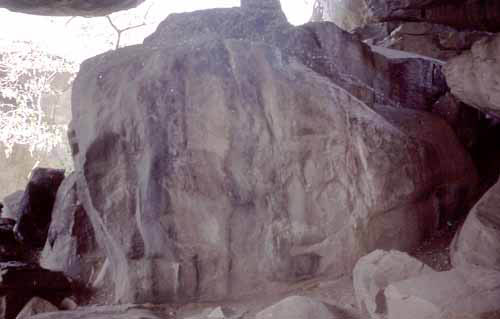
i think it's very clear, but if help is needed i found this....

Some of the paintings... firstly a man riding a horse

and a man possibly being chased by a boar, the poor sod

The paintings are no more than 30,000 years old, relative noobs compared to the carvings.
The Venus of Tan-Tan

A disputed artefact found in Morocco - if this was made by human hands (and personally i reckon so though many others disagree) then it's between 300,000 and 500,000 years old. It may have been purposely covered in red ochre which is a classic sign of ritual use if so. The jury is still very much out on this one.
The Venus of Berekhat Ram
A disputed artefact found in The Golan Heights, some claim it is purposefully tooled, others that it is a product of chance or erosion - i thought this would be of great interest here. To me it looks like an art-work:

If this is an artwork, it was most likely made by Homo Erectus about a quarter of a million years ago, though it is still considered by some as controversial and dubious.
Blombos Cave
This cave in coastal South Africa contains carved an incised ochre

and some of the earliest discovered shell beads, both finds dating to about 70,000 years ago

The Lionman of Hohlenstein Stadel

As old as 40,000 years this Mammoth Ivory carving from the Swabian Alps took about 400 hours to make - for much more info and a modern repro made with authentic flint tools see my thread linked immediately above.
The Venus of Hohle Fels
Europe's oldest Venus figurine as far as i know, dating between 35-40,000 years and found in 2008 in Germany. If you like big girls you are in for a treat here

Hukka Hukka!!
The Mammoth of Vogelherd Cave
About 33,000 years old, from the same Swabian Alp Aurignacian culture as The Lionman above.

The Ivory Horse of Vogelherd Cave
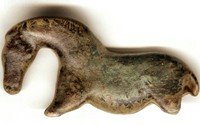
As above, and from the same cave, about 33,000 years.
The Venus of Galgenberg

A lot less Rubenesque, found in Austria and about 30,000 years old.
Chavet Cave
One of the earliest and finest examples of cave paintings in Europe, it was only recently uncovered by a landslide and was the focus of Werner Herzog's movie Cave of Forgotten Dreams


As a fairly recent discovery (1994) dates are still being worked on, but it's about 32,000 years old.
There are ofc a great many amazing sites with cave paintings in Europe, i may link more later after i have finished my OP.
The Venus of Dolni Vestonice
At 25,000 to 29,000 years old, this is reckoned the oldest ceramic article in the world.

The Venus of Willendorf

Found in Austria in 1908, it is made from Limestone that is not found locally and is tinted with Red Ochre - it is believed to be between 25,000 and 28,000 years old.
I'm no expert on the History of Art - it is a particularly massive subject and for many people a life's work, but i am fascinated by it and have read pretty widely on particularly Stone-Age to Bronze-Age art and how it relates to psychology and mythology. I see it as one of the corner stones to developing an understanding of our past and believe that placing Art works in context and seeing their progression encourages accuracy in interpretation, promoting productive discussion, speculation and so forth - when discussing myth, story and scripture as well as other aspects of culture, cognitive development, technology. This is a selection, and by no means a definitive list and i welcome contributions, additions, corrections and so forth - i've learned new things while gathering info for this thread and i'm keen to learn more from reader's contributions, so have at it!
This Site proved me with a useful template/reminders and was worth a mention/credit information, pictures and so forth have been taken from a variety of sources which i will link as i go...
The World's Oldest Artworks
The Daraki Chattann Cave Petroglyphs and Paintings
A cave in India (and World Heritage site) that was possibly first inhabited seven hundred thousand years ago. This contains over 500 carved/pecked cup markings in the cave walls that date to about 250,000 years ago, and the hammer-stones that are thought to have been used to make these have also been unearthed.

Some are interpreted as representing Elephants, though this is the best pic that i could find and it's abstract to say the least:

nearby rocks have been seen by some as other Elephant carvings, though i've seen more likely ones in Mars rocks threads and i don't believe that pictures of them are worthy of inclusion.
There are also many incredible, much later cave paintings
Bhimbetka Rock Carvings
Another site in India (also known as Auditorium Cave) that contains cup marks and engraved lines like Daraki Chattann.

The main reason i include this site are for the amazing stones that have been hammered away at to conclusively resemble Elephants, and are at least 200,000 years old, maybe even more than 500,000:

i think it's very clear, but if help is needed i found this....

Some of the paintings... firstly a man riding a horse

and a man possibly being chased by a boar, the poor sod

The paintings are no more than 30,000 years old, relative noobs compared to the carvings.
The Venus of Tan-Tan

A disputed artefact found in Morocco - if this was made by human hands (and personally i reckon so though many others disagree) then it's between 300,000 and 500,000 years old. It may have been purposely covered in red ochre which is a classic sign of ritual use if so. The jury is still very much out on this one.
The Venus of Berekhat Ram
A disputed artefact found in The Golan Heights, some claim it is purposefully tooled, others that it is a product of chance or erosion - i thought this would be of great interest here. To me it looks like an art-work:

If this is an artwork, it was most likely made by Homo Erectus about a quarter of a million years ago, though it is still considered by some as controversial and dubious.
Blombos Cave
This cave in coastal South Africa contains carved an incised ochre

and some of the earliest discovered shell beads, both finds dating to about 70,000 years ago

The Lionman of Hohlenstein Stadel

As old as 40,000 years this Mammoth Ivory carving from the Swabian Alps took about 400 hours to make - for much more info and a modern repro made with authentic flint tools see my thread linked immediately above.
The Venus of Hohle Fels
Europe's oldest Venus figurine as far as i know, dating between 35-40,000 years and found in 2008 in Germany. If you like big girls you are in for a treat here

Hukka Hukka!!
The Mammoth of Vogelherd Cave
About 33,000 years old, from the same Swabian Alp Aurignacian culture as The Lionman above.

The Ivory Horse of Vogelherd Cave

As above, and from the same cave, about 33,000 years.
The Venus of Galgenberg

A lot less Rubenesque, found in Austria and about 30,000 years old.
Chavet Cave
One of the earliest and finest examples of cave paintings in Europe, it was only recently uncovered by a landslide and was the focus of Werner Herzog's movie Cave of Forgotten Dreams


As a fairly recent discovery (1994) dates are still being worked on, but it's about 32,000 years old.
There are ofc a great many amazing sites with cave paintings in Europe, i may link more later after i have finished my OP.
The Venus of Dolni Vestonice
At 25,000 to 29,000 years old, this is reckoned the oldest ceramic article in the world.

The Venus of Willendorf

Found in Austria in 1908, it is made from Limestone that is not found locally and is tinted with Red Ochre - it is believed to be between 25,000 and 28,000 years old.
edit on 26-8-2014 by skalla because: typos
I have run out of space and for a little while at least, time too.
I know that this list is somewhat Eurocentric and incomplete; as said earlier, please add as you see fit - but please include pictures and links and be sure that it is Art Work of some form or other and not OOParts.
There are many artefacts and sites that i have it in mind to add to this later today, but i will be happy if some one beats me to it and saves me a little effort! Thanks for reading so far and don't be shy
ETA:
Mammoth Ivory Bison, from Zaraysk, Russia. Dated approx 20kya


Woman's Head, from Dolni Vestonice, Cz, approx 26kya

The Venus of Lespugue, approx 25kya

The World's oldest Puppet or Doll? Cz iirc, approx 20 kya

I know that this list is somewhat Eurocentric and incomplete; as said earlier, please add as you see fit - but please include pictures and links and be sure that it is Art Work of some form or other and not OOParts.
There are many artefacts and sites that i have it in mind to add to this later today, but i will be happy if some one beats me to it and saves me a little effort! Thanks for reading so far and don't be shy
ETA:
Mammoth Ivory Bison, from Zaraysk, Russia. Dated approx 20kya


Woman's Head, from Dolni Vestonice, Cz, approx 26kya

The Venus of Lespugue, approx 25kya

The World's oldest Puppet or Doll? Cz iirc, approx 20 kya

edit on 26-8-2014 by skalla because: (no reason given)
edit on 26-8-2014 by skalla because: typo
Rock Art of Tasssili n'Ajjer
A massive World Heritage Site in the Algerian Sahara, see this fabulous PDF



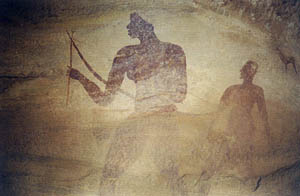

No more than 10,000 years old
Neanderthal Face of The Loire
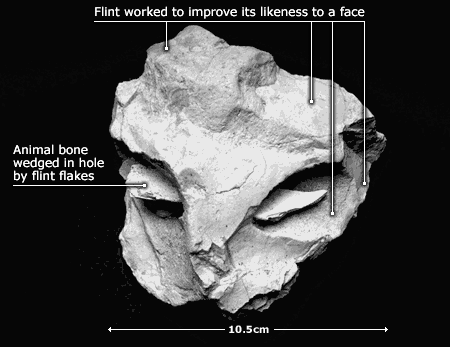
"It should finally nail the lie that Neanderthals had no art," Paul Bahn, the British rock art expert, told BBC News Online. "It is an enormously important object."
Jean-Claude Marquet told BBC News Online: "The sliver of bone was pushed in forcibly and wedged with two pebbles.
"Chance could not have inserted the stones in between the bone and the block in such a balanced way, with the two ends coming out equally either side."
This is thought to be about 35,000 years old and found in a Neanderthal encampment.
A massive World Heritage Site in the Algerian Sahara, see this fabulous PDF





No more than 10,000 years old
Neanderthal Face of The Loire

"It should finally nail the lie that Neanderthals had no art," Paul Bahn, the British rock art expert, told BBC News Online. "It is an enormously important object."
Jean-Claude Marquet told BBC News Online: "The sliver of bone was pushed in forcibly and wedged with two pebbles.
"Chance could not have inserted the stones in between the bone and the block in such a balanced way, with the two ends coming out equally either side."
This is thought to be about 35,000 years old and found in a Neanderthal encampment.
Great thread mate fascinated by this subject, I love that lion man statue. Please keep adding more!
Thought I'd add this in because of it's age and being cave painting, still disputed whether it's human or Neanderthal art work
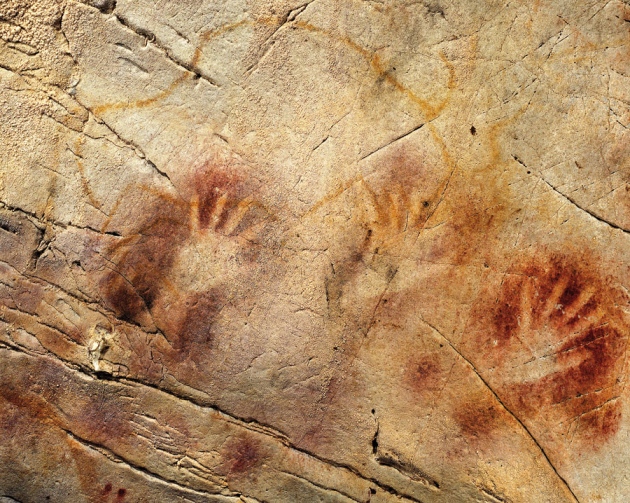
Thought I'd add this in because of it's age and being cave painting, still disputed whether it's human or Neanderthal art work

a reply to: Sparta
Many thanks and a fine addition!
It's from El Castillo Cave in spain and is possibly Europe's oldest Cave Painting site at about 40,000 years. Spain has some amazing cave paintings, plus a sculpture or two that i have heard about in film but cannot find a link or picture to... this clip can provide some info:
check about 4 mins in
ETA: More from El Castillo Cave:
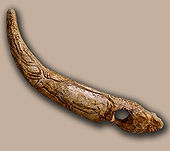
An engraved Baton de Commadement, these were once thought to be wands or similar ritual items. However, modern primitive technologists use reproductions as spear and arrow shaft straighteners, as well as spear throwers similar to a dutch arrow using a cord wound around the spear.


More cave art from this fantastic site. In the brief bit of reading i've done on this site, it seems a groundbreaking discovery that could help show Neanderthals in a new light:
NatGeo
Fascinating Stuff, thanks for posting!
Many thanks and a fine addition!
It's from El Castillo Cave in spain and is possibly Europe's oldest Cave Painting site at about 40,000 years. Spain has some amazing cave paintings, plus a sculpture or two that i have heard about in film but cannot find a link or picture to... this clip can provide some info:
check about 4 mins in
edit on 26-8-2014 by skalla because: i really really hate this keyboard
ETA: More from El Castillo Cave:

An engraved Baton de Commadement, these were once thought to be wands or similar ritual items. However, modern primitive technologists use reproductions as spear and arrow shaft straighteners, as well as spear throwers similar to a dutch arrow using a cord wound around the spear.


More cave art from this fantastic site. In the brief bit of reading i've done on this site, it seems a groundbreaking discovery that could help show Neanderthals in a new light:
At more than 40,800 years old, "this is currently Europe's oldest dated art by at least 4,000 years," said the study's lead author Alistair Pike, an archaeologist at the University of Bristol in the U.K.
The new dates raise the possibility that some of the paintings could have been made by Neanderthals, who are thought to have lived in Europe until about 30,000 or 40,000 years ago. Modern humans are believed to have also been in the area at the time, arriving about 41,500 years ago.
Study co-author João Zilhão goes a step further, suggesting that, if Neanderthals were responsible for some of the Spanish cave art, then perhaps there's no real distinction between them and modern humans.
"It adds to the evidence ... that Neanderthals were a European racial variant of Homo sapiens, not a distinct species," said Zilhão, of the University of Barcelona.
NatGeo
Fascinating Stuff, thanks for posting!
edit on 26-8-2014 by skalla because: (no reason given)
Thanks, what a great collection of images. The artists who worked before written history were just as artistic as anyone working now. When they
finished their painting or galleries they probably had something like an 'opening night', and the music and dancing at those events must have lasted
for hours. Artists know how to party, and this likely goes for these artists as well. Extremely nice thread, and please keep loading up the pics!
Art history was mandatory for my college art courses, and I very much enjoy this topic.
As for stone age human art, it is surprising to learn that the ancient people may have been behaviouraly and cognitively more complex than I first thought. However, the argument that they used ochre as an adhesive may be true, but does not necessarily negate them also using it for decorative purposes.
www.nature.com...
archaeology.about.com...
Body art: Masai warriors wearing ochre body paint in use as far back as the Middle Stone Age

cogweb.ucla.edu...
As for stone age human art, it is surprising to learn that the ancient people may have been behaviouraly and cognitively more complex than I first thought. However, the argument that they used ochre as an adhesive may be true, but does not necessarily negate them also using it for decorative purposes.
Stone Age humans had an elementary knowledge of chemistry. Archaeologists have found evidence that, as long ago as 100,000 years, people used a specific recipe to create a mixture based on the iron-rich ochre pigment.
www.nature.com...
archaeology.about.com...
Body art: Masai warriors wearing ochre body paint in use as far back as the Middle Stone Age

For archaeologists, symbolic behaviour - manifest in art and body decoration - is the great hallmark of modern behaviour and mind. Some even argue that the appearance of symbolism correlates with the origin of syntactical language in our ancestors. The most obvious examples of symbolism are the carved figurines and cave paintings of Upper Palaeolithic Europe (African Later Stone Age). But there is evidence of symbolic behaviour much earlier at Blombos. Ochre, and lots of it.
cogweb.ucla.edu...
edit on 26-8-2014 by InTheLight because: (no reason given)
a reply to: skalla
The one that stands out for me is the Cave of Forgotten Dreams. It exhibits a far more advanced technique in terms of light, texture and perspective than any other cave art I've seen. Very odd if this is from the timeframe it's claimed to be.
Nice thread OP.
The one that stands out for me is the Cave of Forgotten Dreams. It exhibits a far more advanced technique in terms of light, texture and perspective than any other cave art I've seen. Very odd if this is from the timeframe it's claimed to be.
Nice thread OP.
a reply to: Aleister
Cheers Aleister, i shall indeed keep them coming over the next day or two.
I like the idea of the opening night - and this kind of speculation about our ancestors behaving just as we do today is entirely reasonable. Generally we know that many of the caves were decorated over thousands of years (like a modern gallery featuring new artists perhaps) and while many were a chore or indeed an ordeal to reach being deep underground perhaps this is the ancient form of buying a ticket, ie: no guts, no admission.
It's reasonable to suggest that not everyone was allowed entry and maybe the imaginative use of contours in the rock faces to lend a 3D appearance to some of Chauvet's paintings did not "catch on" elsewhere is due to it not being seen by anyone but a select few and perhaps tribes who were not from the immediate locale were excluded.
I love the idea that some ancient dude or dudette had the honour of being cave guardian and belligerently refused entry from a booth at the entrance.
"Your name's not down, you're not coming in" or maybe "If you think i'll let you in wearing that dirty bearskin then you must have rocks in your head - go home and change, and comb your beard while you are at it"
a reply to: beansidhe
Many thanks and you are most welcome! There are a couple of very interesting threads here on those stone balls too
a reply to: InTheLight
thanks for commenting, and for adding those excellent links, i very much enjoyed reading them. It looks to me like the Ochre "potions" were for mixing colour rather than making glues but that is no less fascinating. The use of ochres to add bling to hafted blades reminds of the decorated resin handles the Australian Aboriginals made - i cant find a picture of them right now which is pretty annoying, but i'll persevere and hopefully post some later!
ETA: found them:

i believe that these examples are recent, but the tradition is surely very old indeed.
a reply to: Bilk22
I'm glad you enjoyed my efforts to display some of this art Bilk and thanks for stopping by - part of the reason for making the thread was to (attempt to) show that the advances in human art do not happen in isolation and are part of a gradually accelerating process, though this obviously relies on us having the evidence to hand and given how recently many of these items have been uncovered (many in the last 20 years) this really whets the appetite for future discoveries and expanding our picture and interpretations of the past.
I do get what you say about Chauvet though (as in Cave of Forgotten Dreams) and as i said to Aleister above, maybe entry was restricted and this possibly new technique to lend shape and life to a painting was not widely seen at all so the innovation did not spread for here.
But no doubt new caves will appear - perhaps the artists of Chavet even copied from elsewhere and time will tell.....
Cheers Aleister, i shall indeed keep them coming over the next day or two.
I like the idea of the opening night - and this kind of speculation about our ancestors behaving just as we do today is entirely reasonable. Generally we know that many of the caves were decorated over thousands of years (like a modern gallery featuring new artists perhaps) and while many were a chore or indeed an ordeal to reach being deep underground perhaps this is the ancient form of buying a ticket, ie: no guts, no admission.
It's reasonable to suggest that not everyone was allowed entry and maybe the imaginative use of contours in the rock faces to lend a 3D appearance to some of Chauvet's paintings did not "catch on" elsewhere is due to it not being seen by anyone but a select few and perhaps tribes who were not from the immediate locale were excluded.
I love the idea that some ancient dude or dudette had the honour of being cave guardian and belligerently refused entry from a booth at the entrance.
"Your name's not down, you're not coming in" or maybe "If you think i'll let you in wearing that dirty bearskin then you must have rocks in your head - go home and change, and comb your beard while you are at it"
a reply to: beansidhe
Many thanks and you are most welcome! There are a couple of very interesting threads here on those stone balls too
a reply to: InTheLight
thanks for commenting, and for adding those excellent links, i very much enjoyed reading them. It looks to me like the Ochre "potions" were for mixing colour rather than making glues but that is no less fascinating. The use of ochres to add bling to hafted blades reminds of the decorated resin handles the Australian Aboriginals made - i cant find a picture of them right now which is pretty annoying, but i'll persevere and hopefully post some later!
ETA: found them:

i believe that these examples are recent, but the tradition is surely very old indeed.
a reply to: Bilk22
I'm glad you enjoyed my efforts to display some of this art Bilk and thanks for stopping by - part of the reason for making the thread was to (attempt to) show that the advances in human art do not happen in isolation and are part of a gradually accelerating process, though this obviously relies on us having the evidence to hand and given how recently many of these items have been uncovered (many in the last 20 years) this really whets the appetite for future discoveries and expanding our picture and interpretations of the past.
I do get what you say about Chauvet though (as in Cave of Forgotten Dreams) and as i said to Aleister above, maybe entry was restricted and this possibly new technique to lend shape and life to a painting was not widely seen at all so the innovation did not spread for here.
But no doubt new caves will appear - perhaps the artists of Chavet even copied from elsewhere and time will tell.....
edit on 26-8-2014 by skalla because: (no reason given)
I'm going to jump in to the realm of the very ancient and speculative for this post and show what i've seen described as "Pierre Figurines" and
date from the Lower Palaeolithic, from about 300,000 years ago to about 2.5 million years ago.
These are suggested by some, possibly very few indeed to be modified rocks, where a natural shape in the rock may have been observed to have looked like a particular creature, and then possibly modified to resemble it further. Try to ignore the German text to avoid bias, but it's pretty obvious what the shapes resemble. The question is, are they in some way worked and intentional?

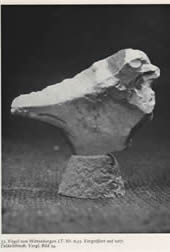



From Wittenbergen in Germany:
From Paleoart site
These are suggested by some, possibly very few indeed to be modified rocks, where a natural shape in the rock may have been observed to have looked like a particular creature, and then possibly modified to resemble it further. Try to ignore the German text to avoid bias, but it's pretty obvious what the shapes resemble. The question is, are they in some way worked and intentional?





From Wittenbergen in Germany:
Professor Walther Matthes often collected from the spoil heaps of previous excavations cataloguing specimens with a sound provenance from across Germany (see images below). Regrettably, following his death, a large part of the collection he amassed was reduced to rubble at the request of his resident University. The items shown below from Wittenbergen, Germany had good provenance and clearly resemble the animals suggested by Walter Matthes if they are not simply recognisable as 'zoomorphs'. All show signs of modification that are consistent with the preservation of features (e.g. stepped, hinged and even overshot fractures) to accomplish the end effect - suggested to be examples of routine incorporation of iconographic properties. The Wittenbergen artefacts date to the Lower Palaeolithic (Eiszeitkunst Im Nordseeraum, Matthes, 1969).
From Paleoart site
the cave paintings are just so beautiful and shows a perfected style. It's not like every person and child has just randomly thrown paint doodles on
the walls. It must of been one person or just the most skilled doing the art, maybe a gallery, spiritual place or an early cinema for story telling.
a reply to: punkinworks10
Please do so, i'm sure you can bring something more than worthy to the thread, I look forwards to it
a reply to: LadyTrick
They are just amazing aren't they? Some are more realistic than others but it's all quite personal - a favourite of mine is the outline of a bear's head, filled in red from Chauvet. It's so simple yet quite stunning and beautifully evocative - the artists must have practiced somewhere and many incised animals of far less detail exist, but perhaps the affinity, intense familiarity and near symbiotic relationship that these people had with the animals depicted aided in the almost intuitive representations they made. I'm still bowled over whenever I see them
Please do so, i'm sure you can bring something more than worthy to the thread, I look forwards to it
a reply to: LadyTrick
They are just amazing aren't they? Some are more realistic than others but it's all quite personal - a favourite of mine is the outline of a bear's head, filled in red from Chauvet. It's so simple yet quite stunning and beautifully evocative - the artists must have practiced somewhere and many incised animals of far less detail exist, but perhaps the affinity, intense familiarity and near symbiotic relationship that these people had with the animals depicted aided in the almost intuitive representations they made. I'm still bowled over whenever I see them
The Cave of Altamira
Known as "The Sistine Chapel of the Quaternary", before this site was explored by cavers in 1880 the world knew nothing of cave paintings.
Source
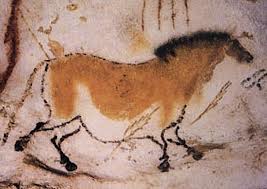

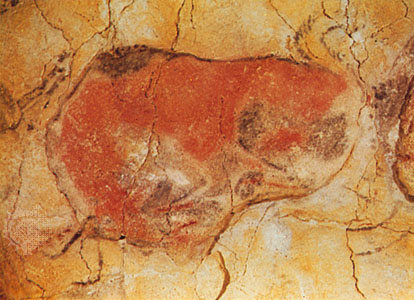

This is another UNESCO World Heritage Site, contours in the rock accentuate the depictions of Bison, Deer, Horses and Boar in Ochre or Haematite and Charcoal. The art is no more than 19,000 years old. It was sealed by a rockslide about 13,000 years ago.
Known as "The Sistine Chapel of the Quaternary", before this site was explored by cavers in 1880 the world knew nothing of cave paintings.
On a summer's day in 1879, an amateur anthropologist and his eight-year old daughter were exploring the area around Santillana del Mar, when they came across an opening to a cave. It had been exposed a few years previously by a landslide provoked by heavy rains. A hunter had chanced upon it the year before, but finding no bears or wolves, he continued on his way. Intrigued, father and daughter lit their charcoal lamps and climbed in through the entrance. As the anthropologist scoured the floor for bones and arrowheads his daughter looked up to the cave's ceiling and exclaimed, “Look Dad, they're cows! ( Mira, Papá, son bueyes )” .
Source




This is another UNESCO World Heritage Site, contours in the rock accentuate the depictions of Bison, Deer, Horses and Boar in Ochre or Haematite and Charcoal. The art is no more than 19,000 years old. It was sealed by a rockslide about 13,000 years ago.
originally posted by: skalla
I'm going to jump in to the realm of the very ancient and speculative for this post and show what i've seen described as "Pierre Figurines" and date from the Lower Palaeolithic, from about 300,000 years ago to about 2.5 million years ago.
That (and maybe the pig below) is without doubt carved purposefully. In saying that, I have no idea how to check for carving marks vs natural stone chipping, but that is a bird, made on purpose, by someone!
There's no reason to dismiss that as anything else. I think it's absolutely wonderful.
a reply to: skalla
I love these heavily illustrated threads. It's like walking through a gallery and how you can stop and think about whatever piece of art catches the imagination.
An idea I've held for years is that art is hardwired into our genes and was experienced by our ancestors before they could articulate or express the sensation. It's not scientific and, no, I can't provide links to peer-reviewed pdfs from academic sites. By 'art,' in this context, I mean the way certain sights just hit us hard and strike a chord. Sunsets, full moons, abstract shapes in fires and the graceful lines of animals...how often did our ancestors pause and appreciate them before they could articulate?
That visceral, jaw-dropping wonder may well have been waiting for a chance to express itself. Maybe the appreciation of art runs in tandem with the earliest stirrings of sentience? Or, chances are, I'm ignorantly romanticising our hominid ancestors? It's what I think, regardless.
I love these heavily illustrated threads. It's like walking through a gallery and how you can stop and think about whatever piece of art catches the imagination.
An idea I've held for years is that art is hardwired into our genes and was experienced by our ancestors before they could articulate or express the sensation. It's not scientific and, no, I can't provide links to peer-reviewed pdfs from academic sites. By 'art,' in this context, I mean the way certain sights just hit us hard and strike a chord. Sunsets, full moons, abstract shapes in fires and the graceful lines of animals...how often did our ancestors pause and appreciate them before they could articulate?
That visceral, jaw-dropping wonder may well have been waiting for a chance to express itself. Maybe the appreciation of art runs in tandem with the earliest stirrings of sentience? Or, chances are, I'm ignorantly romanticising our hominid ancestors? It's what I think, regardless.
a reply to: beansidhe
I'd have to agree with you Beansidhe. Prof Matthes University, who destroyed these items are in my eyes the prime example of an evil institution destroying evidence, an idea that I usually ridicule. As a knapper I can see the skill required to accentuate the natural shapes in the rocks, which would be made by applying inward pressure along the path that a fracture would develop, causing it to terminate earlier than it would otherwise and produce the effects seen. In other areas far more force is applied (and accurately too) than would normally happen, causing flakes to travel much further than in blade making, the "overshoot" mentioned in the quote. The Bird in particular took considerable skill - that beak is a real work of utter intent in my eyes.
ETA: the one below the bird is described as a bison in the source, and that's how I see it, but it's all in the eye of the beholder........
I'd have to agree with you Beansidhe. Prof Matthes University, who destroyed these items are in my eyes the prime example of an evil institution destroying evidence, an idea that I usually ridicule. As a knapper I can see the skill required to accentuate the natural shapes in the rocks, which would be made by applying inward pressure along the path that a fracture would develop, causing it to terminate earlier than it would otherwise and produce the effects seen. In other areas far more force is applied (and accurately too) than would normally happen, causing flakes to travel much further than in blade making, the "overshoot" mentioned in the quote. The Bird in particular took considerable skill - that beak is a real work of utter intent in my eyes.
ETA: the one below the bird is described as a bison in the source, and that's how I see it, but it's all in the eye of the beholder........
edit on 26-8-2014 by skalla because: (no reason given)
a reply to: Kandinsky
Absolutely! It's like the Innate Releasing Mechanisms that Joseph Campbell uses to introduce a volume of his Masks of God series (either Vol 1 or 4, I forget which). I completely agree that it's a natural part of us and the closeness to nature of these artists is surely a reason for their mastery.
Source
Thanks for stopping by Kandinsky, I very much identify with the insights in your responses
Absolutely! It's like the Innate Releasing Mechanisms that Joseph Campbell uses to introduce a volume of his Masks of God series (either Vol 1 or 4, I forget which). I completely agree that it's a natural part of us and the closeness to nature of these artists is surely a reason for their mastery.
The performing bees, birds, fish, or quadrupeds are moved spontaneously from centers of memory antecedent to their own lives. Through each, the species speaks. And since in human traditional rites spontaneous collective responses to formalized displays occur, the earliest creators of the myths and rites of primitive mankind may not have been individuals at all, but the genes of the species. And since in human traditional rites also a certain psychological readiness to respond to specific sign stimuli is to be remarked–particularly among primitives–the earliest individual creators of myths and rites must not have been merely freely inventive fantasists, but inward-gazing, inward-listening seers (shamans), responding to some inner voice or movement of the species. —Joseph Campbell - See more at: www.associativemythology.com...
Source
Thanks for stopping by Kandinsky, I very much identify with the insights in your responses
new topics
-
Mass Shooting Towson, Maryland - 7 shot, 1 possibly dead
Social Issues and Civil Unrest: 2 hours ago -
Trump formally clinches Electoral College victory
2024 Elections: 7 hours ago -
Elon Musk has Meeting with Nigel Farage at Mar-a-Lago
Regional Politics: 10 hours ago -
What's the buzz
General Chit Chat: 11 hours ago -
Was Biden's Mass clemency and pardons one last cash grab?
US Political Madness: 11 hours ago
top topics
-
Trump formally clinches Electoral College victory
2024 Elections: 7 hours ago, 15 flags -
Was Biden's Mass clemency and pardons one last cash grab?
US Political Madness: 11 hours ago, 9 flags -
What's the buzz
General Chit Chat: 11 hours ago, 8 flags -
New job to help stop school shootings
Social Issues and Civil Unrest: 17 hours ago, 5 flags -
Elon Musk has Meeting with Nigel Farage at Mar-a-Lago
Regional Politics: 10 hours ago, 4 flags -
Mass Shooting Towson, Maryland - 7 shot, 1 possibly dead
Social Issues and Civil Unrest: 2 hours ago, 4 flags
active topics
-
Covid Jab and the Alien Invasion
ATS Skunk Works • 19 • : EmmanuelGoldstein -
Mass Shooting Towson, Maryland - 7 shot, 1 possibly dead
Social Issues and Civil Unrest • 7 • : BernnieJGato -
Trump Cancel trip to New Jersey because of drones
Aliens and UFOs • 53 • : DaydreamerX -
Trump formally clinches Electoral College victory
2024 Elections • 3 • : WeMustCare -
School shooting in Madison Wi.
Social Issues and Civil Unrest • 64 • : NorthOS -
Something better
Dissecting Disinformation • 43 • : chr0naut -
Remember These Attacks When President Trump 2.0 Retribution-Justice Commences.
2024 Elections • 114 • : WeMustCare -
Elon Musk has Meeting with Nigel Farage at Mar-a-Lago
Regional Politics • 5 • : nugget1 -
What's the buzz
General Chit Chat • 17 • : DBCowboy -
Could rampant land speculation have caused the Civil War?
History • 39 • : matafuchs

